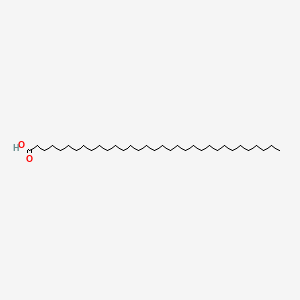| MeSH term | MeSH ID | Detail |
|---|---|---|
| Diabetes Mellitus, Type 2 | D003924 | 87 associated lipids |
| Hypercholesterolemia | D006937 | 91 associated lipids |
| Body Weight | D001835 | 333 associated lipids |
tritriacontanoic acid
tritriacontanoic acid is a lipid of Fatty Acyls (FA) class. Tritriacontanoic acid is associated with abnormalities such as hypercholesterolemia, Metabolic syndrome, Diabetes Mellitus, Non-Insulin-Dependent, Diabetes Mellitus, Insulin-Dependent and Parkinson Disease. The involved functions are known as Fermentation, Process, Longterm Effects, Pressure- physical agent and Lipid Metabolism. Tritriacontanoic acid often locates in Blood, Tissue fiber and A Fibers. The associated genes with tritriacontanoic acid are STN gene. The related lipids are Total cholesterol and blood lipid.
Cross Reference
Introduction
To understand associated biological information of tritriacontanoic acid, we collected biological information of abnormalities, associated pathways, cellular/molecular locations, biological functions, related genes/proteins, lipids and common seen animal/experimental models with organized paragraphs from literatures.
What diseases are associated with tritriacontanoic acid?
tritriacontanoic acid is suspected in hypercholesterolemia, Metabolic syndrome, Diabetes Mellitus, Non-Insulin-Dependent, Diabetes Mellitus, Insulin-Dependent, Parkinson Disease and other diseases in descending order of the highest number of associated sentences.
Related references are mostly published in these journals:
| Disease | Cross reference | Weighted score | Related literature |
|---|
Possible diseases from mapped MeSH terms on references
We collected disease MeSH terms mapped to the references associated with tritriacontanoic acid
PubChem Associated disorders and diseases
What pathways are associated with tritriacontanoic acid
There are no associated biomedical information in the current reference collection.
PubChem Biomolecular Interactions and Pathways
Link to PubChem Biomolecular Interactions and PathwaysWhat cellular locations are associated with tritriacontanoic acid?
Visualization in cellular structure
Associated locations are in red color. Not associated locations are in black.
Related references are published most in these journals:
| Location | Cross reference | Weighted score | Related literatures |
|---|
What functions are associated with tritriacontanoic acid?
Related references are published most in these journals:
| Function | Cross reference | Weighted score | Related literatures |
|---|
What lipids are associated with tritriacontanoic acid?
Related references are published most in these journals:
| Lipid concept | Cross reference | Weighted score | Related literatures |
|---|
What genes are associated with tritriacontanoic acid?
Related references are published most in these journals:
| Gene | Cross reference | Weighted score | Related literatures |
|---|
What common seen animal models are associated with tritriacontanoic acid?
There are no associated biomedical information in the current reference collection.
NCBI Entrez Crosslinks
All references with tritriacontanoic acid
Download all related citations| Authors | Title | Published | Journal | PubMed Link |
|---|---|---|---|---|
| Allen KG et al. | Hypolipidemic effects of modified psyllium preparations. | 2004 | J. Agric. Food Chem. | pmid:15291466 |
| Asvarujanon P et al. | Inhibitory effects of psyllium on rat mineral absorption were abolished by reduction of viscosity with partial hydrolysis. | 2004 | Biosci. Biotechnol. Biochem. | pmid:15322358 |
| Gonlachanvit S et al. | Inhibitory actions of a high fibre diet on intestinal gas transit in healthy volunteers. | 2004 | Gut | pmid:15479674 |
| Liu YC et al. | Effects of psyllium on plasma total and lipoprotein cholesterol and hepatic cholesterol in hamsters fed n-3 PUFA or n-6 PUFA with high cholesterol levels. | 2004 Nov-Dec | Ann. Nutr. Metab. | pmid:15564767 |
| Arlian LG et al. | Antigenic and allergenic analysis of psyllium seed components. | 1992 | J. Allergy Clin. Immunol. | pmid:1560169 |
| Nakamura Y et al. | Beta-sitosterol from psyllium seed husk (Plantago ovata Forsk) restores gap junctional intercellular communication in Ha-ras transfected rat liver cells. | 2005 | Nutr Cancer | pmid:15860444 |
| Sulli MM | OTC product: metamucil plus calcium for regularity and calcium supplementation. | J Am Pharm Assoc (2003) | pmid:15868765 | |
| Moreyra AE et al. | Effect of combining psyllium fiber with simvastatin in lowering cholesterol. | 2005 | Arch. Intern. Med. | pmid:15911730 |
| Wang HJ et al. | A randomised, controlled comparison of low-dose polyethylene glycol 3350 plus electrolytes with ispaghula husk in the treatment of adults with chronic functional constipation. | 2005 | Drugs R D | pmid:15991881 |
| Ziai SA et al. | Psyllium decreased serum glucose and glycosylated hemoglobin significantly in diabetic outpatients. | 2005 | J Ethnopharmacol | pmid:16154305 |
| Frohna WJ | Metamucil bezoar: an unusual cause of small bowel obstruction. | 1992 | Am J Emerg Med | pmid:1616534 |
| Clausen MR et al. | Colonic fermentation of dietary fibre to short chain fatty acids in patients with adenomatous polyps and colonic cancer. | 1991 | Gut | pmid:1653178 |
| Hallert C et al. | Ispaghula husk may relieve gastrointestinal symptoms in ulcerative colitis in remission. | 1991 | Scand. J. Gastroenterol. | pmid:1654592 |
| Dikeman CL et al. | Dietary fibers affect viscosity of solutions and simulated human gastric and small intestinal digesta. | 2006 | J. Nutr. | pmid:16549450 |
| Steinhoff B | The first HMPC community herbal monographs. | 2006 | Phytomedicine | pmid:16564162 |
| Muñoz X et al. | Occupational asthma related to aescin inhalation. | 2006 | Ann. Allergy Asthma Immunol. | pmid:16597087 |
| Leng-Peschlow E | Plantago ovata seeds as dietary fibre supplement: physiological and metabolic effects in rats. | 1991 | Br. J. Nutr. | pmid:1662073 |
| Coggrave M et al. | Management of faecal incontinence and constipation in adults with central neurological diseases. | 2006 | Cochrane Database Syst Rev | pmid:16625555 |
| Ejderhamn J and Strandvik B | Serum bile acids in relation to disease activity and intake of dietary fibers in juvenile ulcerative colitis. | 1991 | Digestion | pmid:1667392 |
| Kecmanovic DM et al. | Bulk agent Plantago ovata after Milligan-Morgan hemorrhoidectomy with Ligasure. | 2006 | Phytother Res | pmid:16708408 |
